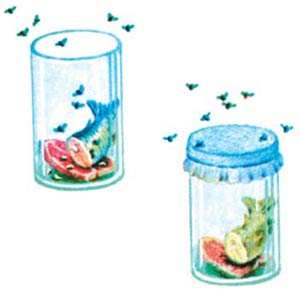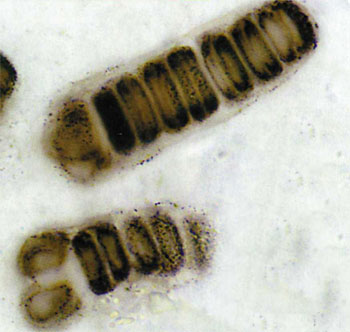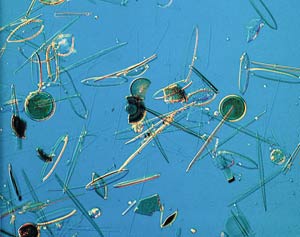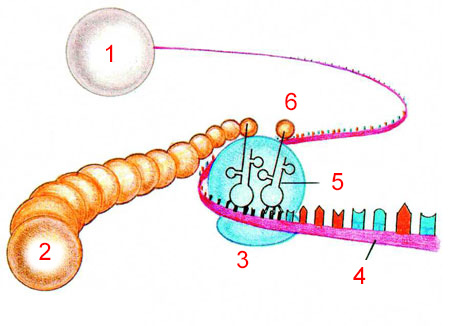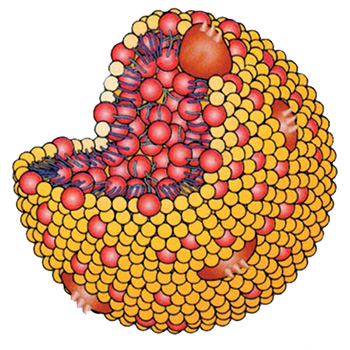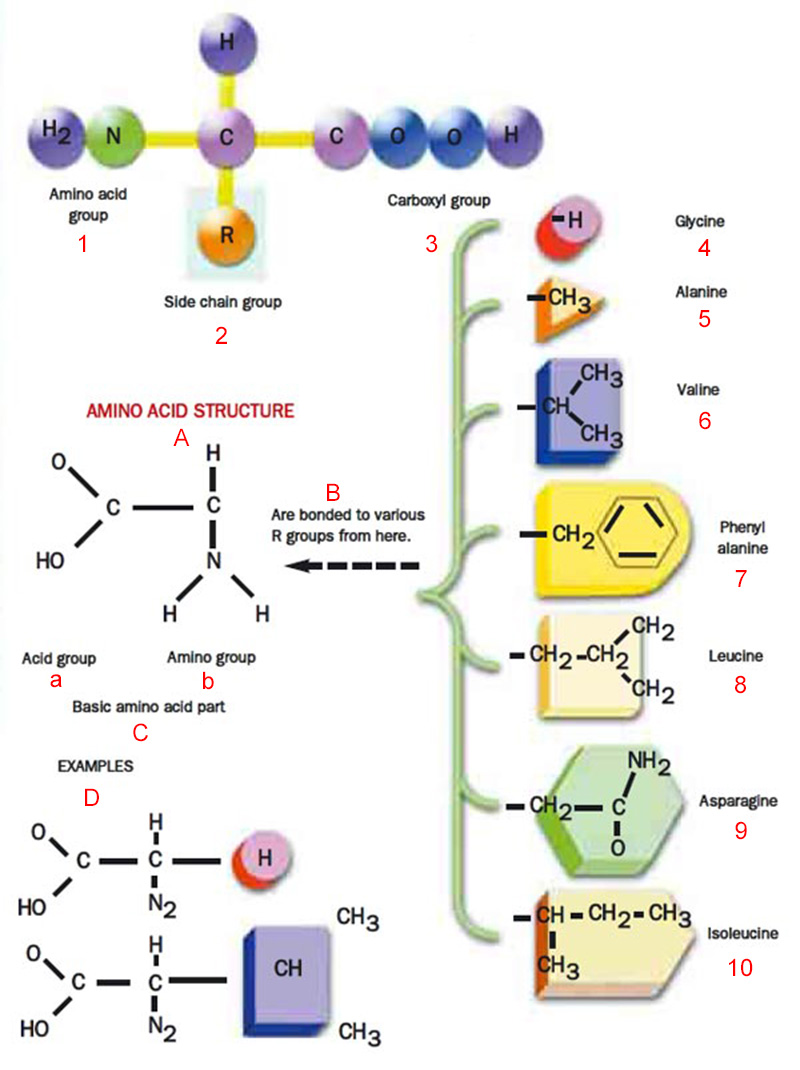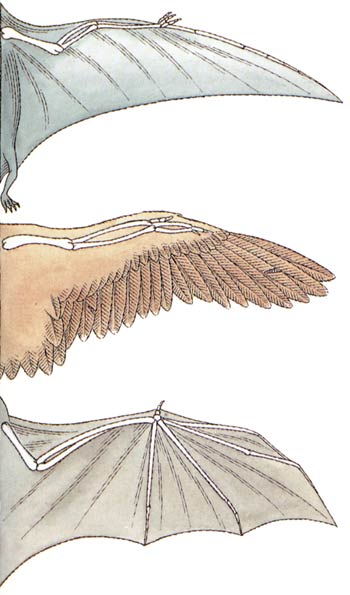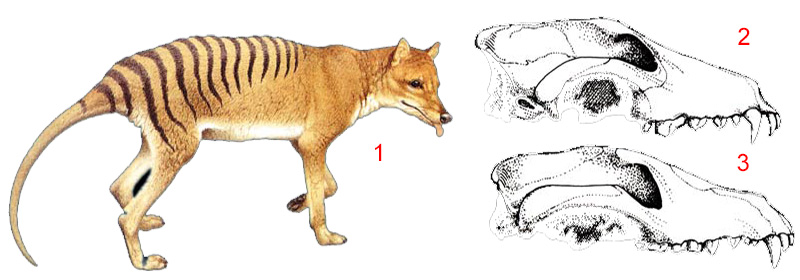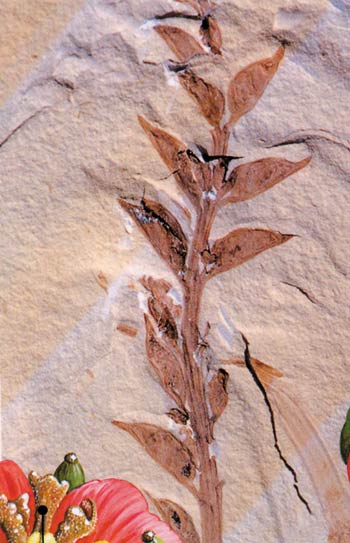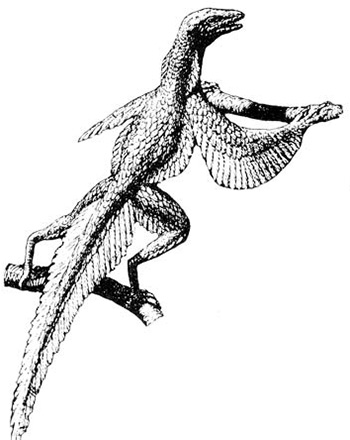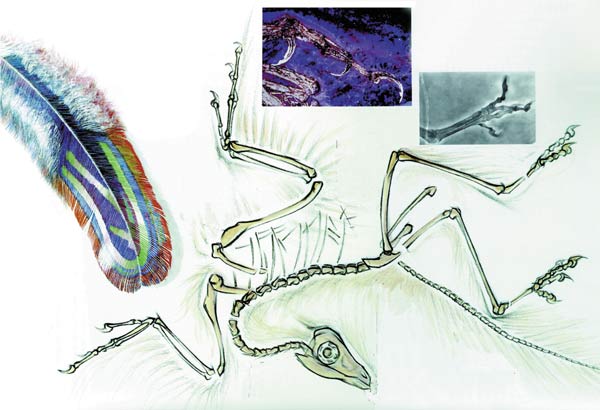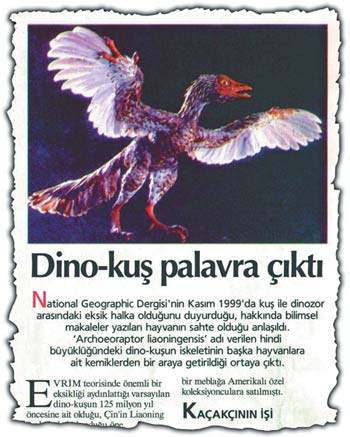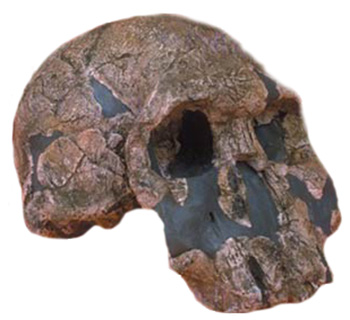Bigotry: The Dark Danger
The Evolution Impasse 1

DOWNLOAD THE BOOK
CHAPTERS OF THE BOOK
< <
2 / total: 11
AAbiogenesis
This is the theory that lifeless matter came together to form a living organism. Also known as the theory of Spontaneous Generation, this idea has persisted since the Middle Ages. (Also see Spontaneous generation.) In Medieval times, it was widely accepted that maggots were generated from food scraps, clothe moths from wool and mice from wheat! Interesting experiments were devised to prove this belief. One 17th-century physicist by the name of J.B. Van Helmont thought that if he spread a few grains of wheat on a dirty cloth, mice would be generated. 1 And when maggots appeared in rotting meat, they were regarded as proof that life could arise from lifeless matter. Only later was it understood that maggots did not come about spontaneously, but from the nearly microscopic eggs that adult flies laid on the meat. The theory of spontaneous generation was shown to be totally false by the famous 19th-century French scientist, Louis Pasteur, who summarized his findings in this triumphant sentence: Never will the doctrine of spontaneous generation recover from the mortal blow struck by this simple experiment.2 Today the theory of abiogenesis has been discarded in favor of the theory of biogenesis, which holds that life comes from only from life. (See: Biogenesis.) But some evolutionist circles that still defend the idea that life was formed long ago from some chance combination of lifeless matter. But they have been unable to prove their claims scientifically, and their attempts to do so have been inconclusive. (See Miller Experiment, the and Fox Experiment, the.) Aboriginal peoplesBefore Europeans discovered Australia, the only people there were Aboriginals, the descendents of groups who migrated to the north coast of Australia from Southeast Asia 50,000 years ago and who, in time, spread to all parts of the subcontinent. Before the Europeans came to Australia in 1788, there were some 300,000 Aboriginals living there, divided into 500 tribes. The newly-arrived Europeans regarded them as “primitive” and undertook to exterminate them, employing extraordinarily savage means. By the end of the extermination, there were few Aboriginal survivors from the original 500 tribes. Of the Australian population today, only one in a hundred persons is of Aboriginal ancestry. 3
According to Darwin, the fittest were white Europeans. Asian and African races fell behind in this struggle. Darwin went further to suggest that they would soon lose their struggle for survival and be totally annihilated: At some future period not very distant as measured by centuries, the civilized races of man will almost certainly exterminate, and replace the savage races throughout the world. At the same time the anthropomorphous apes . . . will no doubt be exterminated. The break between man and his nearest allies will then be wider, for it will intervene between man in a more civilized state, as we may hope, even than the Caucasian, and some ape as low as the baboon, instead of as now between the negro or Australian and the gorilla. 4 As we see, Darwin placed Australian Aboriginals on the same level as gorillas. He did not consider the Aboriginals to be human beings and believed that those who were exterminating them were only killing gorilla-like animals. After Darwin, some evolutionists stated that “if human beings and apes descended from a common ancestor, there must be somewhere in the world a transitional form (half-human and half-ape) that has still not totally evolved.” (See Transitional form). Because Aboriginals have slightly larger eyebrow protrusions, a more downwardly slanted jaw and a smaller brain volume than Western peoples, they were thought to be living examples of transitional species. In order to produce proofs of evolution, evolutionist paleontologists together with fossil hunters who accepted the same theory dug up Aboriginal graves and took skulls back to evolutionist museums in the West. Then they offered these skulls to Western institutions and schools distributing them as the most solid proof of evolution. Later, when there were no graves left, they started shooting Aboriginals in the attempt to find proof for their theory. The skulls were taken, the bullet holes filled in and, after chemical processes were used to make the skulls look old, they were sold to museums. This inhuman treatment was legitimated in the name of the theory of evolution. For example, in 1890, James Bernard, chairman of the Royal Society of Tasmania wrote: “the process of extermination is an axiom of the law of evolution and survival of the fittest.” Therefore, he concluded, there was no reason to suppose that “there had been any culpable neglect” in the murder and dispossession of the Aboriginal Australian.5 Today, Aboriginals are regarded as full Australian citizens, but many still suffer social, economic and political discrimination. AdaptationThis is the ability that allows a creature to survive and reproduce in its environment. No two members of the same species resemble each other exactly. They will be of different sizes, colors and temperaments. Because of this distinction, one of them can adapt better to its environment, live longer and reproduce more successfully. This advantage is known as natural selection. The theory of evolution gives an added significance to the process of adaptation, claiming that under conditions that favor continual adaptation, creatures undergo a change in species over time. But this evolutionist claim—that changes in conditions lead to an evolution of species—is false. A species can adapt to change in its environment only to the extent that its genetic potential allows. If that genetic potential does not allow for ready adaptation, then the species cannot adapt to changing conditions and does not survive. No species ever changes into a new one by adapting to new conditions; it always remains a member of the same species. (See Natural selection.) AL 288-1 (The fossil record of Australopithecus afarensis)(See; The Lucy Deceit.) AL 666-1 (The fossil record of Homo sapien)This is the fossil of a jawbone found in 1994 in Hadar, Ethiopia, together with fossils of Australopithecus afarensis. The fossil was dated to 2.3 million years old and displayed characteristics belonging to Homo sapiens, the human species alive today. The jaw structure of fossil AL 666-1 was quite different from that of A. afarensis and the 1.75-million-year-old H. habilis fossil with which it was found. The jawbones of these two species are narrow and quadrangular, similar to those of modern-day apes. But the fossil AL 666-1 has a jaw structure similar to that of modern human beings. In spite of the fact that fossil AL 666-1 has been determined to belong to the Homo (human) genus, evolutionists hesitate to interpret it as such. This is because the age of this fossil is calculated at 2.3 million years, much earlier than the age accepted for the Homo genus as a whole.
Algae
Algae are photosynthesizing organisms that live everywhere: in both fresh and salt water, desert sand, underground hot springs, and even under snow and ice. They vary in shape and size, from single-celled organisms to kelp up to 60 meters (196.85 feet) long. . By their photosynthesizing, they break down CO2 and release a large amount of the oxygen into the atmosphere. The origins of algae go back to very early times. Fossilized algae have been found that date from 3.1 to 3.4 billion years ago. How algae came to be is one of those questions that have left evolutionists at an impasse. They claim that the first cell evolved over time to form algae and for this reason, the algae are a primitive form of plant. But two factors show this explanation to be false: First, the theory of evolution has still been unable to explain how the first plant cell came into being. And, second, algae do not have the primitive structure one would expect. On the contrary, they are complex organisms whose living examples are indifferent from the earliest fossils known. An article in Science News explains the similarity between the first algae and algae known today: Both blue-green algae and bacteria fossils dating back 3.4 billion years have been found in rocks from S. Africa. Even more intriguing, the pleurocapsalean algae turned out to be almost identical to modern pleurocapsalean algae at the family and possibly even at the generic level.6 The German scientist, Professor Hoimar Von Ditfurth, makes the following comment on the structure of so-called “primitive” algae:
The oldest fossils so far discovered are objects fossilized in minerals which belong to blue-green algae, more than 3 billion years old. No matter how primitive they are, they still represent rather complicated and expertly organized forms of life. 7 When we examine the structures that algae use to form their cell walls, we see that these organisms are by no means basic and primitive. The organic polyamine they use to produce their tissues is a complex chemical material, and to build their cell walls, algae use the longest polyamine chain found in nature. As the algae go through the process of photosynthesis together with complex chlorophyll, they also produce a yellowish-gold colored pigment called xanthophylls. These single-celled organisms are fishes’ major source of Vitamin D and have a complex structure designed for a special purpose. 8 Just as evolutionists have been unable to account for the origins of the first cells, so they cannot explain how these first plant cells gave rise to the first algae cells, whose complex structure is no different from algae living today. AltruismThe mechanism of natural selection that Darwin proposed foresees stronger living things and those best adapting to the natural conditions in their geographical location surviving and continuing down the generations, and the unfit and weaker being eliminated. According to the mechanism of natural selection adopted by Darwinism, nature is an arena where living organisms fight to the death for a chance to survive and where the weak are eliminated by the strong. Therefore, according to this claim, every living thing has to be strong and overcome others in all areas in order to survive. Such an environment has no place for such concepts as altruism, self-sacrifice or cooperation, because these can operate against the interests of each individual. For that reason, every living thing must be as self-oriented as possible and think only of its own food, its own home, and its own protection and security. In fact, however, nature is not solely an environment consisting solely of selfish and savage individuals in which every living things competes for survival, and strives to eliminate or neutralize all others. On the contrary, nature is full of examples of altruism and rational cooperation, even when individuals risk death, the loss of their own interests. Despite being an evolutionist himself, Cemal Yildirim explains why Darwin and other evolutionists of his day imagined nature to be solely a battlefield: Since the majority of scientists in the 19th century were confined to their work rooms, studies or laboratories and did not go to examine nature directly, they were easily taken in by the thesis that living things were solely at war. Even such a prestigious scientist as Huxley was unable to escape this error. 9 In his book Mutual Aid: A Factor in Evolution, dealing with cooperation among animals, the evolutionist Peter Kropotkin expresses the error into which Darwin and his followers fell: . . . the numberless followers of Darwin reduced the notion of struggle for existence to its narrowest limits. They came to conceive the animal world as a world of perpetual struggle among half-starved individuals, thirsting for one another's blood. . . . In fact, if we take Huxley, . . . were we not taught by him, in a paper on the “Struggle for Existence and its Bearing upon Man,” that, “from the point of view of the moralist, the animal world is on about the same level as a gladiators' show. The creatures are fairly well treated, and set to, fight hereby the strongest, the swiftest, and the cunningest live to fight another day.”. . . But it may be remarked at once that Huxley's view of nature had . . . little claim to be taken as a scientific deduction. . . . 10 Evolutionist scientists interpreted certain features that could clearly be seen in nature in order to support the ideology to which they were devoted. The war that Darwin imagined to dominate all of nature is indeed a great error, because the natural world is not full of living things that fight for their own interests alone. Many species are helpful towards other species and, more importantly, are even altruistic and self-sacrificing toward members of their own. Evolutionists are unable to account for the self-sacrificial behavior they encounter in nature. The authors of an article on the subject in one scientific journal reveal this helplessness: The question is why do living beings help one another? According to Darwin’s theory, every animal is fighting for its own survival and the continuation of its species. Helping other creatures would decrease its own chances of surviving, and therefore, evolution should have eliminated this type of behavior, whereas it is observed that animals can indeed behave selflessly. 11 Honeybees, for example, will sting to death any intruder that attacks their hive. By doing this they are actually committing suicide. Because since their stings lodge in the enemy during the stinging process, a number of their internal organs are torn out of their bodies. The honeybees give up their own lives to ensure the security of the hive as a whole. Despite being a particularly ferocious reptile, the crocodile displays an astonishing gentleness towards its young. After they hatch from the eggs, it carries them in its mouth to the water. Subsequently, it carries them either in its mouth or on its back until they are old enough to look after themselves. Whenever the young crocodiles perceive any danger, they immediately retreat to in their mothers’ mouth for shelter. Yet the crocodile is both exceedingly ferocious and also devoid of conscience. One would therefore expect it to eat its young as food without a moment’s hesitation, rather than protecting them. Among other species, some mothers have to leave the community in which they live until their young are weaned, and thus expose themselves to considerable risks. Some animal species care for their young for days, for months or even years after they are born or hatched. They provide them with food, shelter and warmth and protection from predators. Many birds feed their young between four and 20 times an hour throughout the day. Among mammals, mothers face different problems. They have to eat better while suckling their young and must therefore hunt for more food. Yet as the young gain weight, the mother constantly loses it. What one would expect an animal devoid of consciousness to do is to abandon its young after birth, because animals cannot even conceive of what these tiny creatures need. Yet they actually assume all the responsibility for their offspring. Living things are altruistic not only when it comes to protecting their young from danger. They have also been observed to behave most considerately and helpfully towards others of their kind in the community they live in. One example can be seen when nearby food sources decline. In that event, one might expect stronger animals to rise to the top, neutralize the weaker ones, and consume all the food resources for themselves. Yet events do not actually transpire as evolutionists imagine. In his book, the well-known evolutionist Peter Kropotkin cites several examples of this: In the event of a food shortage, ants begin using the supplies they have stored. Birds migrate en masse in search of food, and when too many beavers start living in one pond, the younger ones head north and the older ones south.12 As you can see, there is no ruthless fight to the death for food or shelter among these living things. On the contrary, even under the most difficult conditions, excellent harmony and solidarity are shown. It is as if these creatures work to ameliorate existing conditions. However, one very important point needs to be borne in mind: These living things possess no rational mind with which to make decisions. There is therefore only one possible explanation for the way in which determine a particular objective and work together to attain it, even deciding on the soundest course for all members of the community—namely, God’s creation. Confronted by these facts throughout nature, evolutionists’ claim to the effect that “Nature is a battleground, and the selfish and those who protect their own interests emerge victorious” is completely invalidated. In the face of these features of living things, one well-known evolutionist, John Maynard Smith, addressed the following question to evolutionists: Here one of the key questions has to do with altruism: How is it that natural selection can favor patterns of behavior that apparently do not favor the survival of the individual? 13 Amino acids
Amino acids are molecules, the building blocks of the proteins that make up living cells. More than 200 different amino acids are found in nature, but of these, only 20 kinds make up the protein in living creatures. Certain of these 20 amino acids combine with one another, forming a series of chemical bonds that create proteins with various functions and characteristics. There are basic proteins, composed of about 50 amino acids, and other proteins are composed of thousands of amino acids. If a single amino acid is lacking in the structure of a protein—if it should alter its position, or if a single amino was added to the chain—that protein would be reduced to a useless series of molecules. For this reason, every amino acid must be in exactly the right place, in exactly the right order. The theory of evolution claims that life came to be as a matter of chance—but it certainly cannot explain how this extraordinary order was formed by chance. Although he’s an evolutionist, the American geologist William R. Stokes admits this fact in his book entitled, Essentials of Earth-History:
An article in the January, 1999 edition of Science News explains that there is still no explanation as to how proteins are formed: “that it would not occur during billions of years on billions of planets each covered by a blanket of concentrated watery solution of the necessary amino acids.”14 . . . no one has ever satisfactorily explained how the widely distributed ingredients linked up into proteins. Presumed conditions of primordial Earth would have driven the amino acids toward lonely isolation. 15 Deliberate manipulations performed under laboratory conditions have not been able to produce the amino acids required to form a protein. Experiments done in this area have either been unsuccessful or, as with the Miller Experiment, employed invalid methods. The Miller Experiment used substances that did not exist in the primitive atmosphere and created an environment that was not to be found in that atmosphere. What was created as a result were right-handed amino acids, which are not found in the structure of living proteins (See Miller Experiment, the.) Evolutionists still cannot explain how amino acids could have formed by chance, yet they persist in their claim that just the right acids, in the proper number and arrangements, somehow brought proteins into being. This is one of the greatest impasses faced by the theory of evolution. (See Protein.)
AmphibiansFrogs, toads, salamanders and caecilians are all amphibians, scale-less vertebrates able to live on both land and in the water. There are about 4,000 different species. Because amphibians are able to live on land as well as in the water, evolutionists have claimed that they are a “transitional form” in the movement of vertebrate life from water to land. According to the evolutionist scenario, fish first evolved into amphibians, which later developed into reptiles. But there is no proof for this. Not a single fossil has been found that proves that a half-fish or a half-amphibian ever lived.
In this book, Vertebrate Paleontology and Evolution, the noted evolutionist writer Robert L. Carroll says that in fact, we have no fossils of any intermediate form between early amphibians and rhipidistian fish. 16 Colbert and Morales, evolutionist paleontologists, make the following comment on the amphibians’ three classes—frogs, salamanders and caecilians. There is no evidence of any Paleozoic amphibians combining the characteristics that would be expected in a single common ancestor. The oldest known frogs, salamanders, and caecilians are very similar to their living descendants.17 Up until about 60 years ago, an extinct fossilized fish called the Coelacanth, estimated to be 410 million years old, was touted in evolutionist sources as the transitional form between fish and amphibians. But the fact that this fish, still alive and anatomically unchanged was caught in the Indian Ocean invalidated these evolutionist claims. (See Coelacanth.) In the evolutionist scenario, the second stage is the evolution of amphibians to reptiles and their movement from the water to the land. But there is no solid fossil discovery to support this claim. On the contrary, there remain very great physiological and anatomical differences between amphibians and reptiles.
For example, take the structure of the eggs of the two different species. Amphibians lay their eggs in water. Their eggs have a very permeable, transparent membrane and a gelatin-like consistency that allows them to develop in water. But because reptiles lay their eggs on the ground, they are designed for a dry climate. Reptile eggs are amniotic with a strong rubbery shell that admits air, but keeps water out. For this reason, the fluid needed by the young is stored within until they hatch. If amphibian eggs were laid on the ground, they would soon dry out, and the embryos inside would die. This poses a problem for any evolutionist explanation of how reptiles evolved in stages from amphibians: For the very first amphibians to begin living entirely on land, their eggs would have had to transform into amniotic eggs within a single generation. How this switch could have suddenly occurred cannot be explained by the evolutionist mechanisms of natural selection and mutation. Again, the fossil record leaves the origins of reptiles with no evolutionist explanation. The noted evolutionist paleontologist, Robert L. Carroll, admits this in an article entitled “Problems of the Origin of Reptiles”: Unfortunately not a single specimen of an appropriate reptilian ancestor is known prior to the appearance of true reptiles. The absence of such ancestral forms leaves many problems of the amphibian-reptilian transition unanswered. 18 The same fact is admitted by the late evolutionist paleontologist, Stephen Jay Gould, of Harvard University: “No fossil amphibian seems clearly ancestral to the lineage of fully terrestrial vertebrates (reptiles, birds, and mammals)."(See Movement from Water to land, the.)19 Analogous organ
Some organs superficially appear to be similar and perform the same function. For example, their wings allow butterflies and birds to fly; and both cats and beetles use their legs to walk. But these creatures have completely different genetic and anatomical structures. This kind of similarity is only superficial. 20 Darwin stated that creatures with similar (so-called homologous) organs were related to one another by evolution, and that these organs must have been developed in some common ancestor. However, his assertion rests on no proof and was merely a supposition made on the basis of external similarities. From Darwin’s time until now, no solid evidence has been discovered to substantiate these assertions. In the light of this, evolutionists no longer call these organs homologous—that is, coming from some common ancestor—but analogous, or showing similarity without being related through evolution. (See Morphological homology.) But many species among which evolutionists have been unable to establish an evolutionary connection do have similar (homologous) organs. The wing is the best known example. Bats, which are mammals, have wings and so do birds. Flies and many varieties of insects have wings, but evolutionists have not been able to establish any evolutionary connection or relationship among these various classes. According to evolutionary theory, wings came to be by chance in four independent groups: in insects, flying reptiles, birds and bats. When evolutionists try to explain these four instances by the mechanisms of natural selection/mutation and assert a similarity of structure among them, biologists come up against a serious impasse. Mammals are one of the most concrete examples that draw the evolutionary thesis into a blind alley. Modern biology accepts that all mammals are divided into two basic categories: those with placentas, and marsupials. Evolutionists suppose that this difference came into existence with the first mammals and that each category underwent a different evolutionary history, independently of the other. But it is interesting that in each of these two categories, there are almost two “identical pairs”. Wolves, cats, squirrels, anteaters, moles and mice with their similar features belong both to the category of mammals with placentas and marsupials.21 In other words, according to the theory of evolution, totally independent mutations must have produced these two categories of creatures by chance! Of course, this is impossible.
One of the interesting similarities between placental mammals and marsupials is that between the North American wolf and the Tasmanian wolf. The first is classed as a mammal with a placenta; the second as a marsupial. (It is supposed that contact between marsupials and placental was severed when Australia and its costal islands separated from the continent of Antarctica—and that there were no species of wolves at that time.) But structurally, that the skeletons of the North American wolf and the Tasmanian wolf are almost identical. As the above illustration shows, their skulls match almost exactly. Such similarities, which evolutionist biologists cannot accept as examples of homology, demonstrate that similar organs do not prove the thesis of evolution from a common ancestor. AnalogyEvolutionists try to establish an ancestor-descendent relationship between living creatures on the basis of certain perceived structural similarities between them. But some creatures have organs that perform a similar function, but no evolutionary link can be established between them. This similarity is known as analogy, and such organs are called analogical. Analogical organs are different in structure and development, but the same in functions.22 For example, the wings of birds, bats, and insects are functionally the same, but there is no evolutionary connection among them. Therefore, evolutionists have been unable to establish any common connection between these similar appendages and have been forced to admit that they are the products of separate developments. For example, the wings of birds and insects must have arisen through different chance events than those through which bats’ wings evolved. For those who want to establish an evolutionary connection solely on the basis of similarities, this is a major obstacle. They have never been able to explain how a structure as complex as a wing could have come into being by chance, and so must explain this separately for each creature. (See Homology; Homologous organs.) Many other such situations have led evolutionists into an impasse. (See Analogous organ, above.) Angiosperm
This is a name given to the most common flowering plants, of which there are more than 230.000 species that grow in many environments, even on ocean and in deserts. Fossils found of these plants clearly contradict the evolutionists’ claims. The fossil record indicates that no primitive transitional form has been found for any one of 43 different families into which angiosperms have been classified. This fact was already known in the 19th century, and Darwin called the origin of angiosperms an “abominable mystery.” All the research performed since Darwin’s day has not been able to offer any evolutionist explanation for the origin of these plants. In his book entitled, Paleology of Angiosperm Origins, the evolutionist paleontologist, N.F. Hughes, made this admission: With few exceptions of detail, however, the failure to find a satisfactory explanation has persisted, and many botanists have concluded that the problem is not capable of solution, by use of fossil evidence. 23 And Daniel Isaac Axelrod’s article, “The Evolution of Flowering Plants,” had this to say: The ancestral group that gave rise to angiosperms has not yet been identified in the fossil record, and no living angiosperm points to such an ancestral alliance. 24 The fact that the fossil record of angiosperms reveals no evolutionary ancestor, and that such highly complex living things such as flowering plants came into being all at once is an indication that they were created. Inorganic EvolutionInorganic evolution attempts to explain by chance processes the formation of the world and the universe before the appearance of living things. Those who try to explain everything in terms of evolution espouse the materialist proposition that the universe has existed forever (that it was never created) and that it is a product of chance, with no plan, design or purpose. Evolutionists in the 19th century, with its primitive scientific level of achievement, actively supported this view, but its claims were invalidated in the 20th century. The idea of an eternal universe was first to be abandoned. Information gathered since the 1920s has proven that the universe came into being from nothing at a particular point in time called the Big Bang. That is, the universe is not eternal, but was created from nothing. (See Big Bang Theory.) In the first half of the 20th century, Georges Politzer became a great supporter of materialism and Marxism. In his book, Elementary Principles of Philosophy, he came out in favor of the model of an eternal universe, as opposed to one that was created: The universe was not a created object. If it were, then it would have to be created instantaneously by God and brought into existence from nothing. To admit creation, one has to admit, in the first place, the existence of a moment when the universe did not exist, and that something came out of nothingness. This is something to which science cannot accede.25 In supporting the idea of the eternal universe, he thought that science was on his side. But before long, science called Politzer’s bluff: To admit creation, one has to admit ...that something came out of nothingness. In other words, the universe did have a beginning.
Anthropic Principle, theOne of the several claims demolished by 20th-century science is that of chance. Research conducted since the 1960s has shown that all the physical balances in the solar system—indeed, in the entire universe—have been very finely regulated in order to support human life. The deeper research has penetrated, the more it has shown that the laws of physics, chemistry and biology; basic forces such as gravity and electromagnetism, and the structures of all atoms and elements are just as they need to be to support human life. Western scientists today refer to this extraordinary creation as the Anthropic Principle. In other words, every detail in the universe has been created with the goal of supporting human life. There are some 300 billion galaxies in the universe, each containing approximately as many stars. Eight major planets circle in great harmony around our Sun, which is one of those stars. Of these, only the Earth possesses conditions suited to life. Today, many scientists admit the impossibility of the universe being a collection of random clouds of hydrogen matter forming the stars that form galaxies, of matter thrown out randomly as the result of exploding stars, or of heavier elements coming together at specific points in such a way as to give rise to planets. In the face of this, Sir Fred Hoyle, who opposed the Big Bang theory for many years, expressed the astonishment he felt: The Big Bang theory holds that the universe began with a single explosion. Yet as can be seen, an explosion merely throws matter apart, while the big bang has mysteriously produced the opposite effect—with matter clumping together in the form of galaxies.26 An article in the well-known magazine Science refers to the wondrous equilibrium at the beginning of the universe: If the density of the universe matter had been a little more, then the universe, according to Einstein's Theory of Relativity, would never expand due to the attraction forces of atomic particles, and would have recollapsed to turn into a point. If the density had initially been a little less, then the universe would have expanded at the highest speed, and the atomic particles would not have been able to attract and capture one another, and stars and galaxies would never have been formed. Naturally, we, too, would not have existed! According to the calculations made, the difference between the initial real density of the universe and the critical density beyond which there is no likelihood of its formation is less than a quadrillion of a hundredth. This is like placing a pen on its sharp end that it can stay so even after one billion years. Moreover, this balance gets more delicate as the universe expands. 27 Adherents of the theory of evolution try to account for this extraordinary order in the universe in terms of chance effects. Yet it is doubtless irrational and illogical to expect interconnected coincidences to give rise to such a complex order. Since chance can be calculated mathematically, we can see the impossibility of such a thing happening. It has been calculated that the probability of an environment suited to life emerging through an explosion such as the Big Bang are 1 in 10 x 10123. This calculation was performed by the famous British mathematician Roger Penrose, a colleague of Stephen Hawking. In mathematics, Probabilities less than 1 in 1050 are regarded as essentially zero. The number in question is a trillion, trillion, trillion times larger than 1 in 1050—a number that shows that the universe cannot be accounted for in terms of chance. Roger Penrose comments on this inconceivably vast number: This now tells how precise the Creator's aim must have been, namely to an accuracy of one part in 10 x 10123. This is an extraordinary figure. One could not possibly even write the number down in full in the ordinary denary notation: it would be 1 followed by 10123 successive 0's. Even if we were to write a 0 on each separate proton and on each separate neutron in the entire universe—and we could throw in all the other particles for good measure—we should fall far short of writing down the figure needed. 28 AnthropologyAnthropology is the science that investigates human origins together with its biological, social and cultural characteristics. This science began with the impetus to learn about human history; in fact, its Greek roots mean the science of human beings. After Charles Darwin established his evolutionary theory of the origins and development of living things in the 19th century, interested scientists started to propose one new idea after another about the evolution of human beings. Scientists wanted to learn about the development of human societies, how they changed and became politically organized, and how they developed art and music. As a result of all their efforts, the science of anthropology developed various branches of expertise in its study of the history of humanity: physical anthropology, cultural anthropology, and so forth. But after Darwin proposed the theory of evolution, cultural anthropology began to study human beings as cultural animals, and physical anthropology investigated them as biological organisms. As a result of this distorted way of thinking, anthropology became the domain of evolutionist scientists, whose unrealistic and partisan views prevailed. Antibiotic resistanceWhen any species of bacteria are constantly exposed to a given antibiotic, later generations of them begin to show resistance to it—and eventually that antibiotic has no further effect on them. Evolutionists assume that bacteria’s developing resistance to antibiotics is proof for evolution. They say that this resistance develops as a result of mutations that occur in the bacteria. However, this increasing resistance is not the result of bacterial mutations. Bacteria had resistance ability before being exposed to antibiotics. Despite the fact that it is an evolutionist publication, Scientific American made the following statement in its March, 1998 issue: Many bacteria possessed resistance genes even before commercial antibiotics came into use. Scientists do not know exactly why these genes evolved and were maintained. 29 The fact that genetic information afforded bacterial resistance before the invention of antibiotics invalidates the claims of evolutionists.
Since bacterial ability of resistance existed years before the discovery of antibiotics, the respected scientific journal Medical Tribune related this interesting finding in its December 29, 1988 issue: In 1845, sailors on an . . . Arctic expedition were buried in the permafrost and remained deeply frozen until their bodies were exhumed in 1986. Preservation was so complete that six strains of nineteenth-century bacteria found dormant in the contents of the sailors' intestines were able to be revived! When tested, these bacteria were found to possess resistance to several modern-day antibiotics, including penicillin. 30 Since the medical world now knows that this kind of resistance was present in some bacteria before the discovery of penicillin, it is definitely erroneous to claim that bacterial resistance is an evolutionary development. In bacteria, the development of immunity occurs in this way: In any one species of bacteria, there are countless genetic variations. Some of them, as mentioned above, have genetic information that gives them resistance to some medicines. When bacteria are exposed to a certain medicine, the non-resistant variations are killed off. But the resistant variations survive and multiply even more. After a while, the rapidly multiplying resistant bacteria take the place of the non-resistant bacteria that had been destroyed. Then, since most bacteria in a colony are resistant to that particular antibiotic, it becomes ineffective against them. But the bacteria are the exact same species of bacteria. There was no process of evolution. Transmission of resistance among different species of bacteriaNot only can some bacteria inherit their resistance to antibiotics from previous immune generations; they can also have resistance genes from other bacteria transferred to them. Genes are transmitted between bacteria by means of plasmids, tiny DNA circles in bacteria in which resistance genes are often found encoded. These genes allow the bacteria to become resistant to various toxic materials in their surroundings. Resistance genes may also be found in the chromosomal DNA in bacteria. A chromosome is much larger than the plasmids in bacterial cells; it is a molecule that determines the cells’ function and division.
A bacterium with genetic immunity to antibiotics can transfer its genetic information through plasmids to another bacterium. Resistance genes are sometimes transferred through viruses. In this case, a virus transfers the resistance gene it withdrew from one bacterium to another. And when a bacterium dies and disintegrates, another bacterium can absorb the resistance gene it releases into the immediate environment. A non-resistant bacterium can easily add this gene to its own DNA molecules, because such resistance genes are usually in the form of tiny DNA particles called transposons that can easily be added to other DNA molecules. In such ways, a whole colony of resistant bacteria can be formed in a short time from one resistant bacterium. This has nothing to do with evolution: The genes that make bacteria resistant did not develop through any process of mutation. Only existing genes are distributed among bacteria. Ape-Human Genetic-Similarity Falsehood, theDrawing up the human gene map within the framework of the Human Genome project was a major scientific development. However, evolutionist publications have distorted a number of the project’s results. It is claimed that the genes of chimpanzees and humans bear a 98% similarity and assumed that this shows their closeness, which is used as evidence for the theory of evolution. However, this is in fact a false proof that evolutionists exploit by making use of society’s lack of information on the subject. First of all, the concept so frequently touted by evolutionists—that 98% similarity between human and chimpanzee DNA—is a deceptive one. In order to claim that the genetic structures of human beings and chimpanzees bear a 98% similarity, the entire chimpanzee genetic code would have to be mapped, in the way the human one has. Then the two would have to be compared, to obtain the results. Yet no such results are yet available: While the human genetic map has been completed, the chimpanzee equivalent has not. In fact, the “98% similarity between human and ape genes” slogan was deliberately produced for propaganda purposes many years ago. This “similarity” is a highly exaggerated generalization, based on a similarity in the amino acid sequences in between 30 and 40 of the basic proteins present in man and ape. Sequence analysis of the DNA strings corresponding to these proteins was performed using a method known as “DNA hybridization.” and only these limited proteins were compared. Yet there are around 30,000 genes in human beings and these genes encode some 200,000 proteins. There is thus no scientific justification for claiming, on the basis of a similarity in 40 proteins out of 200,000, any 98% resemblance between human and ape genetics. The DNA comparison of those 40 proteins is also questionable. Two biologists named Charles Sibley and Jon Edward Ahlquist carried out the comparison in 1987 and published the results in the Journal of Molecular Evolution.31 However, another scientist by the name of Sarich examined their data and concluded that they’d used a method of questionable reliability and had exaggeratedly interpreted the data. 32 Basic proteins are essential molecules commonly found in many other living things. The structures of the proteins in all living things, not just of chimpanzees, bear a close similarity to those of proteins in human beings. For example, genetic analyses reported in New Scientist revealed a 75% similarity between the DNA of nematodes (millimeter-long worms that dwell in the soil) and humans!33 This, of course, does not imply that there is only a 25% difference between human beings and nematodes. When the genes of the fruit fly species Drosophila were compared with human genes, a 60% similarity was determined.34 Analyses of some proteins seem to show that man is actually closer to very different living things. In one study performed at Cambridge University, certain proteins in terrestrial organisms were compared. Astonishingly, in almost all the specimens involved, human beings and chickens were found to bear the closest relationship to one another. Our next closest relative is the lizard. 35 Another example used by evolutionists with regard to the so-called “genetic similarity between man and ape” is that there are 46 chromosomes in human beings and 48 in gorillas. Evolutionists assume that chromosome numbers are an indication of an evolutionary relationship. But in fact, if this logic employed by evolutionists were valid, then man would have a much closer relative than the chimpanzee—the potato! Both human beings and potatoes have exactly the same number of chromosomes. These examples demonstrate that the concept of genetic similarity constitutes no evidence for the theory of evolution. Not only are the genetic similarities incompatible with the evolutionary family tree proposed, but they actually provide totally conflicting results. In addition, the similarities discovered are actually evidence for creation rather than for evolution. It is perfectly natural for the bodies of humans and other living things to exhibit molecular similarities, because all living things are made up of the same molecules, use the same water and atmosphere, and consume foods made up of the same molecules. Naturally, their metabolisms—and thus, their genetic structures—will tend to resemble one another. However, this is no evidence that they evolved from a common ancestor. Another example will help elucidate this: All the buildings in the world are constructed from similar materials—bricks, iron, cement, and so forth. But this does not imply that these buildings evolved from one another. They were built independently, using common materials. The same principle applies to living things. Apart from the superficial similarity between human beings and apes, there is no question of their being closer to each other than to other animals. In terms of ability, a bee producing honeycombs that are geometrical miracles, or a spider weaving a web that is a marvel of engineering, are much closer to man than are apes. In some respects, one can even say that these invertebrates are superior.
Yet the huge gulf between human beings and apes is too vast to be bridged with evolutionist claims and myths. Apes are animals and, in terms of consciousness, are no different to horses or dogs. Human beings, on the other hand, are conscious, possess free will and are capable of thought, speech, reasoning, decision-making and judgment. All these attributes are processes of the soul they possess. It is this soul that gives rise to the major difference between human beings and animals. Man is the only entity in nature to possess a soul. No physical similarity can bridge this widest gulf between humans and other living things. Arboreal TheoryThis is one of two evolutionist theories regarding how reptiles—a terrestrial life form—began to fly. According to the arboreal theory, the ancestors of birds were tree-dwelling reptiles that gradually developed wings by leaping from branch to branch. (The other view is the cursorial theory, which maintains that birds took to the air directly from the ground.) But this first theory is utterly imaginary, and has no scientific evidence to support it. John Ostrom, who first proposed the cursorial theory, admits that the proponents of both hypotheses can do nothing more than speculate. He wrote that his theory of “cursorial predator” was in fact speculative—but the arboreal theory was also speculative. 36 In addition, none of the transitional forms (See Transitional form) that should have existed on Earth in ages past has ever been discovered (See Cursorial theory; also Origin of birds, the.) ArchaeopteryxThis extinct species of bird lived 140 million years ago, during the Jurassic period. The fact that Archaeopteryx had some characteristics that differ from those of modern birds led evolutionists to suppose that it was a transitional species between them and their dinosaur ancestors. According to the theory of evolution, small dinosaurs called Velociraptors or Dromesaurs evolved wings and began to fly; Archaeopteryx is thought to be the ancestor of today’s flying birds. However, the latest research on Archaeopteryx fossils shows that this claim has no scientific basis. This species was not an awkwardly flying transitional species, merely an extinct bird with characteristics different from those of its modern counterparts. Here is the latest research data on Archaeopteryx: - Originally, the fact that this creature had no sternum was cited as the most important proof that it could not fly. The muscles needed for flight are attached to the sternum located at the base of the rib cage. (Modern flying and flightless birds and bats—mammals which belong to a totally different family—all have a sternum.) But the seventh Archaeopteryx fossil found in 1992 showed this argument to be false. This particular fossil had a sternum, which evolutionists had long discounted. The following words are from an article in Nature magazine: The recently discovered seventh specimen of the Archaeopteryx preserves a partial, rectangular sternum, long suspected but never previously documented. This attests to its strong flight muscles, but its capacity for long flights is questionable.37
This discovery has removed the basic foundation for the claim that Archaeopteryx was a half- evolved flightless bird. - There is no difference between the wings of modern birds and those of Archaeopteryx: Both have the same asymmetrical feather structure, which indicates that this creature was an excellent flyer. As the noted paleontologist Carl O. Dunbar pointed out, ‘Because of its feathers, [Archaeopteryx is] distinctly to be classed as a bird.’ 38 - Another fact that emerges from the feathers of Archaeopteryx is that the creature was warm-blooded. As we know, reptiles and dinosaurs were cold-blooded—that is, their body temperature was determined by the external ambient temperature. One of the most important functions of birds’ feathers is to stabilize keep their body temperature. The fact that Archaeopteryx had wings shows that unlike dinosaurs, it was warm-blooded. That is, it was a true bird that needed a covering of feathers to regulate its body temperature. -The two most important points that evolutionist biologists consider as evidence that Archaeopteryx was a transitional form are its teeth and the claws on its wings.
But those claws on its wings and its teeth do not indicate that Archaeopteryx had any relation to reptiles. Two species of birds alive today, Tauraco corythaix and Opisthocomus hoazin, have claws that enable them to grip on to branches. Each of these species is wholly a bird, with no relation to reptiles. Therefore, the fact that Archaeopteryx had claws on its wings does not substantiate the claim that it was a transitional form. Neither do its teeth. Evolutionists were wrong to claim that these teeth were a reptilian characteristic. In fact, teeth are not a typical characteristic of reptiles. Some living reptiles do not have teeth at all—turtles, for example. More importantly, while no birds with teeth are alive today, when we look at the fossil record, we see that there was a species of bird with teeth that lived at the same time or later than Archaeopteryx. Until very recently in geologic history, there was a group of birds that could be called toothed. In addition, the tooth structure of Archaeopteryx and other toothed birds is quite different from that of dinosaurs, their supposed ancestors. Noted ornithologists such as L. D. Martin, J. D. Stewart and K. N. Whetstone determined that that the surface of the teeth of Archaeopteryx and other toothed birds were straight and had wide roots. However, the teeth of theropod dinosaurs—the supposed ancestors of birds—had serrated teeth and have straight roots. 39
-Some recently discovered fossils show in a different way that the evolutionist scenario invented for Archaeopteryx is untenable. In 1995, Lianhai Hou and Zhonghe Zhou of the Vertebrate Paleontology Institute in China discovered a new fossil that they called Confuciusornis. It is the same age as Archaeopteryx (about 140 million years old) and has no teeth. Its beak and feathers and skeleton are the same as those of modern birds. And, like Archaeopteryx, it had claws on its wings, as well as a feature called a pygostyle that supported its tail feathers. In short, this creature is the same age as Archaeopteryx, the supposed ancestor of all modern birds. But it was itself very much like modern birds. This contradicts the evolutionist thesis that Archaeopteryx is the primitive ancestor of all birds. 40
Another fossil found in China in 1996 caused even more of a stir. L. Hou, L. D. Martin and Alan Feduccia announced in Science magazine the discovery of a 130-million-year-old fossil called Liaoningornis. It had a breastbone to which the flying muscles were attached, as in modern birds. And in other ways too, this creature was no different from modern birds. The only difference was that it had teeth—which indicated, contrary to the evolutionist claims, that teeth in birds did not constitute a primitive characteristic. 41 Accordingly, Alan Feduccia wrote in Discovery magazine that Liaoningornis invalidates the claim that birds evolved from dinosaurs.42 Eoalulavis is another fossil that has invalidated evolutionist claims about Archaeopteryx. At 120 million years old, it is 30 million years younger than Archaeopteryx, but its wing structure is the same, and it still seen in some modern species of birds. This proves that 120 million years ago, creatures no different from present-day birds flew through the air. 43 One clear proof that Archaeopteryx is not a transitional form between reptiles and birds came from a fossil found in China in the year 2000. Named Longisquama, it was the fossil of a bird that lived in Central Asia 220 million years ago. The well-known magazines Science and Nature, as well as BBC television, reported about this fossil that the entire body of the fossil—estimated to have lived 220 million years ago— was covered in feathers, had a furcula like present-day birds (as well as Archaeopteryx), and that its feathers had hollow shafts. This invalidates the claims that Archaeopteryx was the ancestor of present-day birds. The fossil discovered is 75 million years older than Archaeopteryx—in other words, it existed with fully avian features 75 million years before the creature that evolutionists claimed to have been the forerunner of birds. 44 So it became clear that Archaeopteryx and other archaic birds were not transitional forms. Their fossils did not demonstrate that various bird species evolved from one another. On the contrary, they proved that modern-day birds and some species of birds like Archaeopteryx lived together. In short, some characteristics of Archaeopteryx show that this creature was no transitional form. And now two noted proponents of the theory of evolution—paleontologists Stephen Jay Gould and Niles Eldredge of Harvard University—have acknowledged that Archaeopteryx was never a transitional form but a so-called “mosaic” creature with several different characteristics.45 ArchaeoraptorThis fossil is said to have been discovered in China in 2001, but was actually a false construction. The hoax was detected through detailed analysis by researchers, who published the results in Nature magazine: The Archaeoraptor fossil was announced as a missing link and purported to be possibly the best evidence since Archaeopteryx that birds did, in fact, evolve from certain types of carnivorous dinosaur . . . But Archaeoraptor was revealed to be a forgery in which bones of a primitive bird and a non-flying dromaeosaurid dinosaur had been combined. . . . We conclude that Archaeoraptor represents two or more species and that it was assembled from at least two, and possibly five, separate specimens. . . Sadly, parts of at least two significant new specimens were combined in favor of the higher commercial value of the forgery, and both were nearly lost to science. Paleontology was also badly damaged by the Piltdown forgery and the “lying stones” of Johann Beringer, and many fossils have been unwittingly or deliberately subjected to misleading reconstruction. 46 (See Piltdown Man.)
Atapuerca Skull, theIn 1995, three Spanish paleontologists from the University of Madrid found a fossil in the Gran Dolina cave in Spain’s Atapuerca region. It was a section of the facial bones of an 11 year-old child that is identical to human children living today. But the child died 800,000 years ago! This was a surprising discovery for evolutionists, who did not hope that Homo sapiens (modern-day human beings) lived so long ago. (See Imaginary Human Family Tree, the.)
The December 1996 issue of Discovery magazine gave it wide coverage. This fossil even shook the convictions about evolution of the head of the Gran Dolina research team, Arsuaga Ferreras, who said: We expected something big, something large, something inflated—you know, something primitive. Our expectation of an 800,000-year-old boy was something like Turkana Boy. And what we found was a totally modern face. . . To me this is most spectacular—these are the kinds of things that shake you. Finding something totally unexpected like that. Not finding fossils; finding fossils is unexpected too, and it's okay. But the most spectacular thing is finding something you thought belonged to the present, in the past. It's like finding something like—like a tape recorder in Gran Dolina. That would be very surprising. We don't expect cassettes and tape recorders in the Lower Pleistocene. Finding a modern face 800,000 years ago—it's the same thing. We were very surprised when we saw it. 47
This fossil indicated that the history of Homo sapiens had to be pushed 800,000 years into the past. But according to the human family tree fabricated by evolutionists, H. sapiens could not have lived 800,000 years earlier. Deciding that this fossil belonged to another species, they invented an imaginary species called Homo antecessor and assigned the Atapuerca skull to it. AustralopithecusThis is the first genus of human being in the imaginary evolutionist schema; the name means “southern ape.” This creature is thought to have first appeared in Africa 4 million years ago and lived until one million years ago. All the species of Australopithecus [A. aferensis, A. africanus, A. boisei. A. robustus (or Zinjanthropus)], comprise an extinct genus of apes that closely resembles apes we see today. Their brain volume is the same or slightly smaller than that of a modern chimpanzee. Like modern apes, they had protrusions on their hands and feet to facilitate climbing trees, and their feet were shaped to allow them to grasp tree branches. They were short (130 centimeters, or 51 inches at the most), and like modern apes, males were much larger than the females. Many features of their skulls—the position of their eyes close together, their sharp molar teeth, jaw structure—long arms, and short legs show that they were no different from modern apes.
Despite the fact that Australopithecus had the anatomy of an ape, evolutionists claim that unlike other apes, it walked upright like a human. But the skeletal structure of Australopithecus has been studied my many scientists who reject the validity of this claim. Two world-renowned anatomists, Lord Solly Zuckerman from England and Prof. Charles Oxnard of the U.S.A., did an extensive study of Australopithecus remains and determined that this creature didn’t walk on two feet and moved in a way quite different from that of humans. Lord Zuckerman, with the support of the British government and a team of five experts, examined the bones of this creature for a period of 15 years. Even though he was an evolutionist, he concluded that Australopithecus was a species of ape and that certainly did not walk upright. 48 Studies done by another noted evolutionist anatomist, Charles E. Oxnard, showed that the skeleton of Australopithecus resembles that of a modern orangutan.49 The fact that Australopithecus cannot be considered an ancestor of man is accepted even by evolutionist sources. The well-known French magazine Science et Vie made this the cover story of its May 1999 issue. The story dealt with Lucy, the best-known fossil specimen of A. afarensis, under the title "Adieu Lucy (Goodbye, Lucy)” and detailed the need to remove Australopithecus from the human family tree. The article was based on the discovery of a new Australopithecus, code number St W573: A new theory states that the genus Australopithecus is not the root of the human race... The results arrived at by the only woman authorized to examine St W573 are different from the normal theories regarding mankind's ancestors: this destroys the hominid family tree. Large primates, considered the ancestors of man, have been removed from the equation of this family tree... Australopithecus and Homo (human) species do not appear on the same branch. Man's direct ancestors are still waiting to be discovered. 50 Australopithecus was nothing more than an extinct species of ape, with no relation to human beings whatsoever. Autotrophy Nonsense, theSince all living organisms need food to survive, then the first living thing must have had to make its own food. According to this view, the first living thing capable of producing its own nourishment was an autotrophic one, and other living things then emerged from this organism. However, it is impossible for autotrophs to emerge as in the hostile and simple conditions in early days of this Earth. Autotrophs would have to undergo millions of years of changes in order to acquire their first complex structure. The autotrophic view maintains that the first living thing formed as a complex organism in a simple environment. Yet rather than account for the organism’s appearance, it actually explains how this first living thing fed. Since the theory fails to account for how the first autotroph came into being, it received little support. 51 Avian lungs(See Origin of Avian lungs, the)
Footnotes1.Ozer Bulut, Davut Sagdic, Selim Korkmaz,Biyoloji Lise 3, (“Biology High School 3”) MEB Publishing, Istanbul, 2000, p. 182. 2.From Rene Vallery-Radot, The Life of Pasteur, 1920, Garden City, NY: Garden City Publishing Company, Inc., p.109. http://www.foundersofscience. net/interest1.htm 3.Grolier International Americana Encyclopedia, Vol 2, Danbury:Grolier Incorporated, 1993, pp. 345-346. 4.Charles Darwin, The Descent of Man, 2nd Edition, New York: A L. Burt Co., 1874, p.178. 5.Jani Roberts, “How neo-Darwinism justified taking land from Aborigines and murdering them in Australia”, http://www.gn.apc.org/inquirer/ ausrace.html. 6.“Ancient Alga Fossil Most Complex Yet”, Science News, Vol. 108, 20 September 1975, p. 181. 7.Hoimar Von Ditfurth, The Silent Night of the Dinosaurs, Istanbul: Alan Publishing, November 1996, Trans: Veysel Atayman, p.199. 8.N. Kroger, R. Deutzmann, M. Sumper, “Polycationic Peptides from Diatom Biosilica That Direct Silica Nanosphere Formation”, Science, 286, pp. 1129, 1999. 9.Cemal Yildirim, Evrim Kurami ve Bagnazlik (“The Theory of Evolution and Bigotry”), p.49. 10.Peter Kropotkin, Mutual Aid: A Factor of Evolution, 1902, Chapter I, http://www.calresco. org/texts/mutaid1.htm 11.Bilim ve Teknik magazine, No.190, p. 4. 12.Peter Kropotkin, Mutual Aid: A Factor of Evolution, 1902, Part II. 13.John Maynard Smith, “The Evolution of Behavior”, Scientific American, December 1978, Vol. 239, No.3, p. 176. 14.William R. Bird, The Origin of Species Revisited, Nashville: Thomas Nelson Co., 1991, p. 305. 15.Sarah Simpson, “Life’s First Scalding Steps,” Science News, 155(2), 9 January 1999, p. 16.Robert L. Carroll, Vertebrate Paleontology and Evolution, New York: W. H. Freeman and Co., 1988, p. 304. 17.Edwin H. Colbert, M. Morales, Evolution of the Vertebrates, New York: John Wiley and Sons, 1991, p. 99. 18.Robert L. Carroll, “Problems of the Origin of Reptiles,” Biological Reviews of the Cambridge Philosophical Society, Vol. 44. p. 393. 19.Stephen Jay Gould, “Eight (or Fewer) Little Piggies,” Natural History, No. 1, Jan 1991, Vol. 100, p. 25. 20.Musa Özet, Osman Arpac›, Ali Uslu, Biyoloji 1 (“Biology 1”), Istanbul: Surat Publishing, 1998, p. 129. 21.Dean Kenyon, Davis Percical, Of Pandas and People: The Central Question of Biological Origins, Dallas: Haughton Publishing, 1993, p. 33. 22.Prof. Dr. Eflref Deniz, T›bbi Biyoloji (“Medical Biology”), 4th Edition, Ankara, 1992, p. 369. 23.N.F. Hughes, Paleology of Angiosperm Origins: Problems of Mesozoic Seed-Plant Evolution, Cambridge: Cambridge University Press, 1976, pp.1-2. 24.Daniel Isaac Axelrod, “The Evolution of Flowering Plants,” in Evolution After Darwin: Vol. 1: The Evolution of Life, Ed. by S. Tax, Chicago, IL: University of Chicago Press, 1960, pp. 264- 274. 25.Georges Politzer, Principes Fondamentaux de Philosophie, Paris: Editions Sociales, 1954, p. 84. 26.Fred Hoyle, The Intelligent Universe, London, 1984, p. 184. 27.Bilim ve Teknik [“Science and Technique”] magazine, Vol. 201, p. 16. 28.Michael Denton, Nature’s Destiny, New York: The Free Press, 1998, p. 9. 29.Stuart B. Levy, “The Challenge of Antibiotic Resistance”, Scientific American, March 1998, p. 35. 30.Medical Tribune, 29 December 1988, pp.1, 31.Hubert Journal of Molecular Evolution, Vol. 26, pp. 99-121. 32.Sarich et al., Cladistics, Vol: 5, 1989, pp. 3-32. 33.Karen Hopkin, “The Greatest Apes,” New Scientist, May 15, 1999, p. 27. 34.“Fruit Fly Gene Success,” BBC News, 18 February, 2000. 35.Mike Benton, “Is a Dog More Like Lizard or a Chicken?” New Scientist, Vol. 103, August 16, 1984, p. 19. 36.John Ostrom, “Bird Flight: How Did It Begin?”, American Scientist, January-February 1979, Vol. 67. 37.Kevin Pedian, “Early Bird in Slow Motion,” Nature, 1 August 1996, p. 401. 38.Carl O. Dunbar, Historical Geology, New York: John Wiley and Sons, 1961, p. 310. 39.L.D. Martin, J.D. Stewart, K.N. Whetstone, “The Origin of birds: Structure of the tarsus and teeth,” The Auk, Vol. 97, 1980, p. 86. 40.Pat Shipman, “Birds Do It . . . Did Dinosaurs?.” New Scientist, 1 February 1997, p. 31. 41.“Old Bird,” Discover, Vol. 18, No. 3, 21 March 1997. 43.Pat Shipman, “Birds Do It . . . Did Dinosaurs?, New Scientist, p. 31. 44.Terry D. Jones, John A. Ruben, Larry D. Martin, Evgeny N. Kurochkin, Alan Feduccia, Paul F. A. Maderson, Willem J. Hillenius, Nicholas R. Geist, Vladamir Alifanov, “Nonavian Feathers in a Late Triassic Archosaur.” Science, 23 June 2000, pp. 2202-2205; “Earliest feathers fan controversy,” 22 June 2000, BBC News, http://news.bbc.co.uk/2/hi/science/nature/ 802009.stm. 45.S.J. Gould & N. Eldredge, Paleobiology, Vol. 3, 1977, p. 147. 46.Timothy Rowe, Richard A. Ketcham, Cambria Denison, Matthew Colbert, Xing Xu, and Philip J. Currie, “Forensic palaeontology: The Arc-195 haeoraptor forgery,” Nature, 29 March 2001, Vo.: 410, pp. 539-540. 47.Robert Kunzig, “The Face of an Ancestral Child,” Discover, December 1996, pp. 97-100. 48.Solly Zuckerman, Beyond The Ivory Tower, New York: Taplinger Publications, 1970, pp. 75-94. 49.Charles E. Oxnard, “The Place of Australopithecines in Human Evolution: Grounds for Doubt,” Nature, Vol. 258, p. 389. 50.Isabelle Bourdial, “Adieu Lucy,” Science et Vie, May 1999, No. 980, pp. 52-62. 51.Ozer Bulut, Davut Sagdic, Selim Korkmaz, Lise Biyoloji 3 (“High School Biology 3”), Istanbul: MEB Press, 2000, p. 183. |
|||||||||||||||||||||||||||||||||||||||||||||||||||||||
2 / total 11
You can read Harun Yahya's book The Evolution Impasse 1 online, share it on social networks such as Facebook and Twitter, download it to your computer, use it in your homework and theses, and publish, copy or reproduce it on your own web sites or blogs without paying any copyright fee, so long as you acknowledge this site as the reference.
